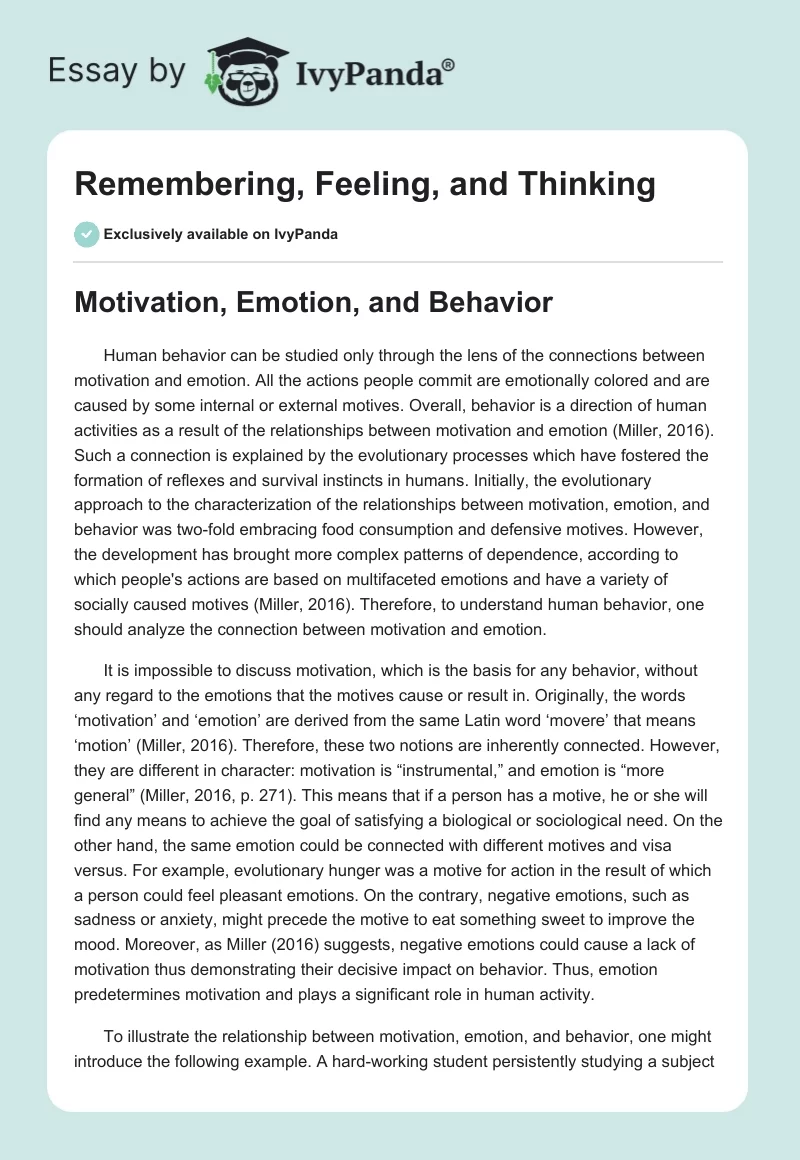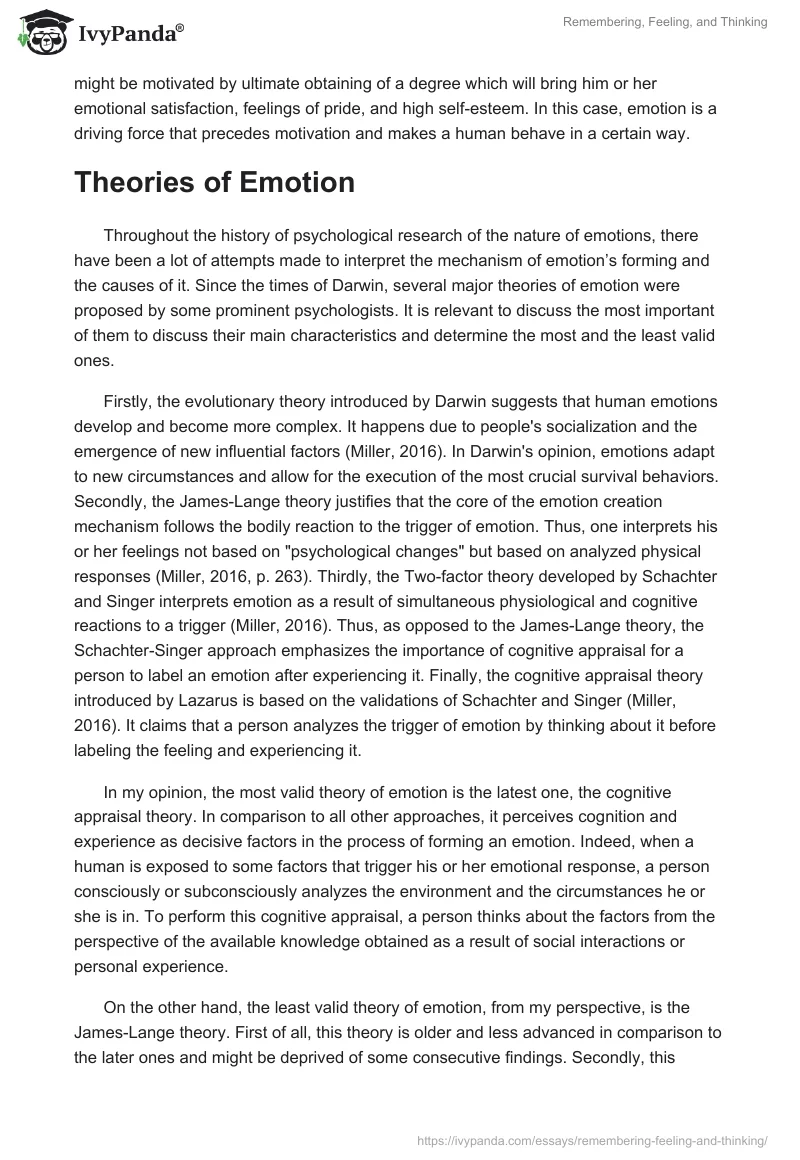Motivation, Emotion, and Behavior
Human behavior can be studied only through the lens of the connections between motivation and emotion. All the actions people commit are emotionally colored and are caused by some internal or external motives. Overall, behavior is a direction of human activities as a result of the relationships between motivation and emotion (Miller, 2016). Such a connection is explained by the evolutionary processes which have fostered the formation of reflexes and survival instincts in humans. Initially, the evolutionary approach to the characterization of the relationships between motivation, emotion, and behavior was two-fold embracing food consumption and defensive motives. However, the development has brought more complex patterns of dependence, according to which people’s actions are based on multifaceted emotions and have a variety of socially caused motives (Miller, 2016). Therefore, to understand human behavior, one should analyze the connection between motivation and emotion.
It is impossible to discuss motivation, which is the basis for any behavior, without any regard to the emotions that the motives cause or result in. Originally, the words ‘motivation’ and ‘emotion’ are derived from the same Latin word ‘movere’ that means ‘motion’ (Miller, 2016). Therefore, these two notions are inherently connected. However, they are different in character: motivation is “instrumental,” and emotion is “more general” (Miller, 2016, p. 271). This means that if a person has a motive, he or she will find any means to achieve the goal of satisfying a biological or sociological need. On the other hand, the same emotion could be connected with different motives and visa versus. For example, evolutionary hunger was a motive for action in the result of which a person could feel pleasant emotions. On the contrary, negative emotions, such as sadness or anxiety, might precede the motive to eat something sweet to improve the mood. Moreover, as Miller (2016) suggests, negative emotions could cause a lack of motivation thus demonstrating their decisive impact on behavior. Thus, emotion predetermines motivation and plays a significant role in human activity.
To illustrate the relationship between motivation, emotion, and behavior, one might introduce the following example. A hard-working student persistently studying a subject might be motivated by ultimate obtaining of a degree which will bring him or her emotional satisfaction, feelings of pride, and high self-esteem. In this case, emotion is a driving force that precedes motivation and makes a human behave in a certain way.
Theories of Emotion
Throughout the history of psychological research of the nature of emotions, there have been a lot of attempts made to interpret the mechanism of emotion’s forming and the causes of it. Since the times of Darwin, several major theories of emotion were proposed by some prominent psychologists. It is relevant to discuss the most important of them to discuss their main characteristics and determine the most and the least valid ones.
Firstly, the evolutionary theory introduced by Darwin suggests that human emotions develop and become more complex. It happens due to people’s socialization and the emergence of new influential factors (Miller, 2016). In Darwin’s opinion, emotions adapt to new circumstances and allow for the execution of the most crucial survival behaviors. Secondly, the James-Lange theory justifies that the core of the emotion creation mechanism follows the bodily reaction to the trigger of emotion. Thus, one interprets his or her feelings not based on “psychological changes” but based on analyzed physical responses (Miller, 2016, p. 263). Thirdly, the Two-factor theory developed by Schachter and Singer interprets emotion as a result of simultaneous physiological and cognitive reactions to a trigger (Miller, 2016). Thus, as opposed to the James-Lange theory, the Schachter-Singer approach emphasizes the importance of cognitive appraisal for a person to label an emotion after experiencing it. Finally, the cognitive appraisal theory introduced by Lazarus is based on the validations of Schachter and Singer (Miller, 2016). It claims that a person analyzes the trigger of emotion by thinking about it before labeling the feeling and experiencing it.
In my opinion, the most valid theory of emotion is the latest one, the cognitive appraisal theory. In comparison to all other approaches, it perceives cognition and experience as decisive factors in the process of forming an emotion. Indeed, when a human is exposed to some factors that trigger his or her emotional response, a person consciously or subconsciously analyzes the environment and the circumstances he or she is in. To perform this cognitive appraisal, a person thinks about the factors from the perspective of the available knowledge obtained as a result of social interactions or personal experience.
On the other hand, the least valid theory of emotion, from my perspective, is the James-Lange theory. First of all, this theory is older and less advanced in comparison to the later ones and might be deprived of some consecutive findings. Secondly, this theory excludes any cognitive analysis of the triggers of emotions. It is inconsistent in the interpretation of physiological responses to different emotions. For example, an increased heart-beat rate might be experienced because of the feeling of excitement or fear. When grounding only on the physiological reactions, one would not be able to label the emotion accurately. Therefore, the numerous theories of emotions justify the complexity of the issue and mean that many perspectives cannot give a single answer to the question of the causes of emotion.
Thinking, Intelligence, and Creativity
The psychological notions of thinking, intelligence, and creativity are closely interrelated. Thinking is “different from perceiving or knowing” some information, but it is rather a process of establishing connections between the known facts to make assumptions about the world (Miller, 2016, p. 722). Thinking is related to both intelligence as the ability to construct complex interconnections with phenomena and information, and creativity. Consequently, creativity might be defined as the ability of a person to invent new ideas that have never existed before and that are effective and the most appropriate (Karwowski et al., 2016). When explaining the type of relationships between the three analyzed elements, one should note that to be creative, a person needs to have a certain level of intellectual development and be capable of thinking.
As the research performed by Karwowski et al. (2016) illustrates, people “with high intelligence … attain almost any range of creativity … scores, … while those with low intelligence are generally not so creative (p.106). This means that creativity level clearly illustrates the intelligence level because, according to research, there were no individuals with low intelligence and high creativity found (Karwowski et al., 2016). Moreover, recent research studies conducted in the field of cognitive psychology show that “intelligence and creativity are driven by similar cognitive processes” (Karwowski et al., 2016, p. 106-107). Thus, it seems like it is impossible to maintain one without another. Therefore, creative thinking and an ability to find novel solutions are based on the level of intellectual development and the flexibility of thinking processes. However, more determinants are influencing an individual’s creativity. For example, many studies have proven that in addition to cognitive abilities, character traits and the features of temperament are influential in developing creativity (Karwowski et al., 2016). Overall, thinking, intelligence, and creativity are the characteristic constituents of a person’s cognitive abilities and exist in interrelation with each other.
References
Karwowski, M., Dul, J., Gralewski, J., Jauk, E., Jankowska, D. M., Gajda, A. … Benedek, M. (2016). Is creativity without intelligence possible? A necessary condition analysis. Intelligence, 57, 105-117.
Miller, H. L. Jr. (Ed.). (2016). The SAGE encyclopedia of theory in psychology. Thousand Oaks, CA: SAGE Publications.


